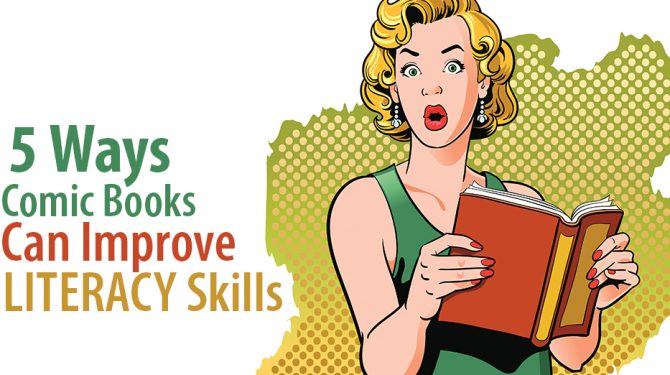Five Ways Comic Books Can Improve Literacy Skills

Being able to read and write can be a superpower for anyone—so why not learn by reading about superheroes? Comic books can be used as a great tool for improving literacy skills, not just for children, but adults too.
At a 2016 Comic-Con in San Diego, California, a panel of education professionals shed some light on the superpowers that comics are filled with, both figuratively and literally. “Idioms, homonyms, homophones—you can see that clearly in the play between text and pictures,” said Lalitha Nataraj, a panelist and librarian. “For that reason, comics are wonderful.”
Another panelist uses Chris Claremont’s X-Men comic book to explain one of the most significant roles comic books play in building literacy skills. “You have Colossus, and he’s this big, giant metal guy. You get a really good sense of what the word colossus means and that’s a good 10-cent word. Banshee’s power is screaming. You have these characters that embody the vocabulary words that they are. That’s something that’s a fun way to learn new words, in addition to the contextual clues,” said James Bucky Carter, author of Building Literacy Connections with Graphic Novels.
There are several ways that comic books can be used to educate learners of all ages.
Motivation
Adults who read at a low level or cannot read at all can be intimidated by books overflowing with text. Comic books deliver small amounts of text on each page that act as stepping stones to longer and more complex texts. With these small amounts of text, readers are exposed to a lot of details without having to decode more words then they can handle.
Reading Comprehension
The sequential artwork in comic books lays the foundation for building reading comprehension skills. You don’t exactly get every detail of the story the way you do while reading a novel. Reading comic books requires a person to read between the lines, draw interpretations, and synthesize the information. By interacting with both the text and images, the reader can easily comprehend and visualize the story. The more they do this, the easier and quicker they can build their reading comprehension skills.
Dialogue
In comic books, readers are exposed to a great deal of dialogue. This especially is valuable for English language learners. Not only is the text short and simplified, but the images display various expressions during these dialogues. For someone who may not know English very well, it helps to read the text and see the expressions on the characters’ faces to draw real meaning from the dialogue.
Writing
Comic books contain basic story elements such as setting, characters, rising action, climax, falling action, and resolution. Each panel in a comic book equals one paragraph. Reading comic books can be a great exercise for adult learners. Not every panel will have text, but every panel will display a story element. With the setting, characters, etc. in place, learners can practice their writing skills by taking what they see and writing their own paragraphs.
Vocabulary
As mentioned above, comic books provide a baseline for learning vocabulary. Characters in comics are very unique, but are also built around various nouns, verbs, and adjectives. Readers can learn new terms through word usage in addition to illustrative support.
Add Comic Books to the Literacy Agenda
Comic books can be the lone wolf in the world of adult literacy. Instructors’ inventory of educational material may consist of online courses, printed workbooks, novels, etc., but not typically comic books. Let comic books join the pack and give them a try—you may be very surprised at how well they work as a building block for learners transitioning into more advanced reading and writing. Then learners can have their own superpowers!
Originally posted by Jennifer Vecchiarelli on Nov. 08, 2018 to proliteracy.org.
